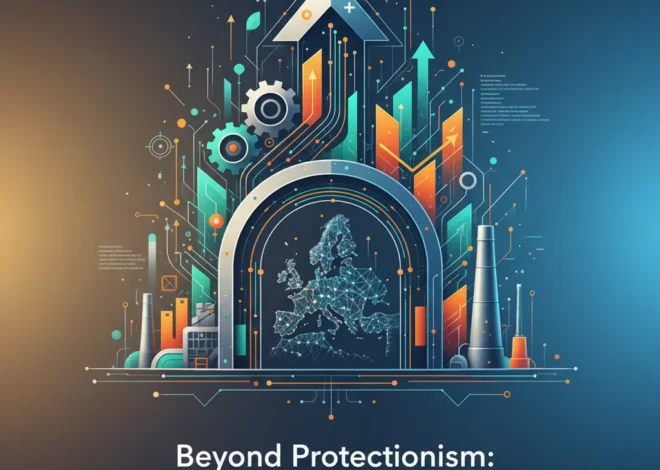
The Unseen Ledger: Analyzing the Economic Ripple Effect of Public Security Crises
In the immediate aftermath of a public safety incident, the focus is rightly on the human cost. The recent news of a mass stabbing on a train, prompting the UK’s Transport Secretary Heidi Alexander to review rail security and consider expanded use of facial recognition CCTV, is a stark reminder of this vulnerability. According to the BBC report, this event has catalyzed a high-level re-evaluation of the nation’s public transport security infrastructure. While the headlines capture the immediate tragedy, for investors, business leaders, and finance professionals, such events trigger a cascade of economic questions that extend far beyond the initial incident. They force us to look at the unseen ledger—the complex interplay between public safety, investor confidence, technological innovation, and the broader economy.
A single security failure is not an isolated event; it is a data point that signals potential systemic risk. This risk is priced into the market in real-time, affecting everything from the stock market valuation of transport operators to the risk premiums on infrastructure bonds. Understanding these financial and economic aftershocks is crucial for navigating an increasingly unpredictable global landscape. The call for enhanced security measures like facial recognition is not merely a policy debate; it represents the dawn of a significant shift in public spending, private investment, and technological adoption, creating both challenges and substantial opportunities across multiple sectors.
The Direct Economic Fallout: More Than Just Headlines
When a critical piece of public infrastructure like a rail network experiences a major security breach, the immediate financial consequences are swift and tangible. The initial costs include emergency response, service shutdowns, and repairs. For a publicly-listed transport company, a single day of network paralysis can result in millions in lost revenue. This directly impacts quarterly earnings and can trigger a negative reaction in stock market trading, as investors recalibrate their expectations for the company’s short-term performance.
Beyond the operator, the ripple effect spreads through the local economy. Commuters are unable to get to work, leading to lost productivity. Supply chains that rely on rail freight can be disrupted. Consumer-facing businesses in and around transport hubs suffer from a sudden drop in footfall. According to a study by the RAND Corporation on the economic consequences of terrorism, transportation systems are often targeted precisely because of their role as economic arteries. Disrupting them maximizes economic pain and erodes public confidence. While the incident in question may not be classified as terrorism, the economic principles of disruption remain the same.
These direct costs are just the beginning. The long-term financial liabilities can be even more significant, involving insurance claims, potential litigation, and regulatory fines. This is where the world of finance and banking becomes deeply intertwined. Insurers must re-evaluate their risk models for public infrastructure, potentially leading to higher premiums for operators across the board. Banks and lenders providing capital for infrastructure projects may demand more stringent security covenants in their loan agreements, increasing the cost of capital for future development.
Investor Sentiment and the Price of Security
The stock market is a barometer of collective sentiment, and it reacts viscerally to perceived increases in risk. A high-profile security failure can tarnish a company’s brand reputation, suggesting a failure in governance and operational management. For investors, this raises critical questions: Is this a one-off event, or does it expose a deeper, systemic weakness? Will the company now face a period of heavy, margin-eroding capital expenditure to upgrade its security? The uncertainty alone can lead to a sell-off, depressing the stock’s value.
However, the market’s reaction is not monolithic. While the transport operator’s stock may fall, companies in the security sector often see a surge in interest. The announcement of a potential government-led review into rail security, with a specific mention of technologies like facial recognition, immediately puts a spotlight on the “securi-tech” industry. This includes a wide range of firms:
- AI and Machine Learning developers specializing in video analytics.
- Biometric hardware and software manufacturers.
- Cybersecurity firms tasked with protecting the vast amounts of data these systems collect.
- Large-scale systems integrators responsible for deploying these complex solutions.
For those engaged in active trading, this creates a classic “rotation” scenario, where capital flows out of the affected sector and into the sectors poised to provide the solution. The economics of the situation dictate that a problem of this scale will be met with significant investment, both public and private. This is where astute investing requires looking beyond the headline and identifying the second- and third-order beneficiaries of the inevitable policy and spending response.
The Rise of “Securi-Tech”: A New Frontier for Financial Technology and Investment
The proposal to deploy more advanced surveillance technology like facial recognition is a clear signal that we are moving beyond traditional security paradigms. This represents a multi-billion dollar opportunity and a new frontier for investment, heavily influenced by developments in financial technology (fintech).
The procurement and deployment of such vast systems are massive undertakings. They are often funded through complex public-private partnerships (PPPs), where government bodies collaborate with private firms. These deals rely on sophisticated financial modeling and are often financed by consortia of banks and institutional investors. The growth in this area is a boon for the project finance departments of major banking institutions.
To better understand the landscape of potential solutions and their financial implications, consider the following comparison:
| Security Technology | Estimated Cost Profile | Key Investment Sectors | Potential Economic Considerations |
|---|---|---|---|
| Traditional CCTV | Low-Medium (Upfront Hardware) | Hardware Manufacturing, Installation Services | High long-term operational cost (manual monitoring), low preventative capability. |
| AI-Powered Facial Recognition | High (Software, Hardware, Data Infrastructure) | AI/ML Software, Semiconductor Chips, Cloud Computing, Cybersecurity | High ROI potential through automation and prevention, but significant R&D and data privacy compliance costs. |
| Behavioral Analytics | Medium-High (Primarily Software) | AI Software, Data Science, IoT Sensors | Less intrusive than facial recognition, focuses on anomaly detection, requires sophisticated algorithms. |
| Blockchain-Based Identity | High (Emerging Technology) | Blockchain Development, DLT Platforms, Fintech | Potential for secure, decentralized identity verification. Addresses privacy concerns but is technologically immature for mass deployment. |
As the table illustrates, the move towards advanced solutions like AI-powered surveillance is a move towards a technology- and data-intensive model. This is where fintech and even speculative technologies like blockchain come into play. Venture capital and private equity are pouring billions into startups that are developing these next-generation security solutions. Furthermore, the immense amount of sensitive data generated by these systems raises profound questions about data integrity and security. Here, blockchain technology, while not a panacea, offers a potential architectural model for creating tamper-proof audit trails of data access, ensuring that surveillance data is used ethically and transparently. According to a report by MarketsandMarkets, the facial recognition market alone is projected to grow from USD 5.0 billion in 2021 to USD 12.9 billion by 2028, a testament to the powerful economic forces at play.
Beyond the Headlines: Decoding the Landmark US-China Deal on TikTok, Rare Earths, and Global Trade
Financing the Future of Safety: The Macroeconomic Perspective
Upgrading an entire nation’s rail security infrastructure is a monumental task with macroeconomic implications. The funding required will likely come from a combination of government budgets, transport operator revenues, and private capital. This large-scale fiscal stimulus will flow directly into the technology and construction sectors, creating jobs and driving innovation. The field of economics provides a framework for analyzing the return on this investment.
The primary return is, of course, the reduction in the “cost of crime.” A study on the economic cost of crime highlights that the total expense to a society goes far beyond direct losses, encompassing healthcare for victims, criminal justice system costs, and lost economic output. By preventing incidents, advanced security systems can deliver a significant, albeit hard to quantify, economic dividend.
Furthermore, a demonstrably safe and secure public transport network is a critical component of a productive modern economy. It boosts consumer confidence, encourages tourism, increases labor mobility, and makes a city or country a more attractive destination for international business and investment. In this sense, spending on security is not just a defensive measure; it is a strategic investment in economic competitiveness. The decisions made by the UK’s Transport Secretary will therefore be watched closely by economists and international investors as an indicator of the government’s commitment to underwriting the stability and security upon which a thriving economy is built.
Anatomy of a Downfall: Petrofac's Collapse and the Hard Lessons for Investors and the Economy
In conclusion, the tragic event on a single train has opened a Pandora’s box of complex financial, technological, and economic considerations. It serves as a powerful case study in how public safety is inextricably linked to market stability and investment trends. For the general public, the goal is a safer commute. For business leaders, it’s a question of operational resilience and risk management. And for the finance and investing community, it is a signal of a profound market shift—a reallocation of capital towards the technologies and companies that will define the future of security. The conversation is no longer just about adding more cameras; it’s about investing in the intelligent, interconnected, and data-driven infrastructure of a safer world, and understanding the powerful economic currents that will shape its development.


